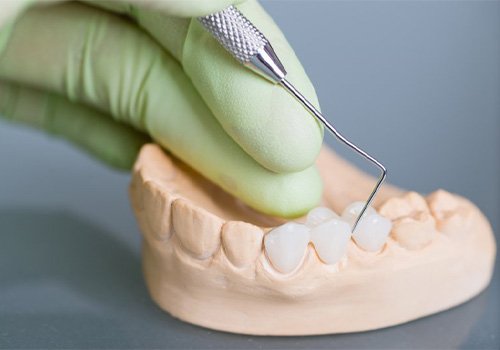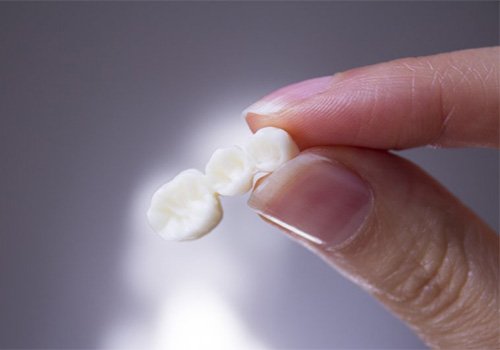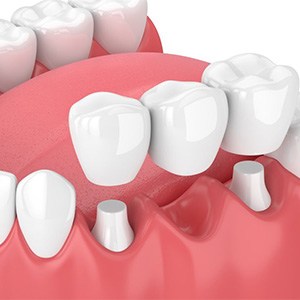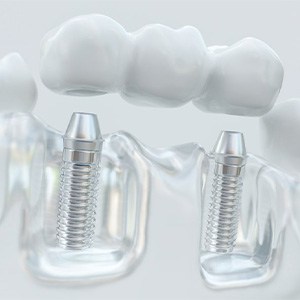Dental Bridges – Kerrville, TX
Fill the Gap With Help
from an Expert
Bridgework can restore your arch of teeth when one or more are missing. We provide custom bridgework designed to look and feel natural in your mouth, restoring form and function and providing a brilliantly aesthetic result. Need to bridge gaps left by missing teeth? Our dental office provides customized dental bridges in Kerrville, TX to replace missing teeth, restoring your smile with form, functionality, and aesthetics. Read on to learn more or give us a call today to schedule an appointment.

Why Choose Carroll R. Butler, DDS Family Dentistry for Dental Bridges?
- Easily Replace Multiple Consecutive Teeth
- Stop Dental Drift and Maintain a Straight Smile
- Advanced Technology Ensures Best-Fitting Restoration Possible
What is a Dental Bridge?

A dental bridge typically involves using two dental crowns that are connected with artificial teeth, or pontics, to bridge a gap in a patient’s smile. In many cases, this restoration can replace one to three missing teeth in a row and can provide stable results that can last many years with proper care. This treatment will generally require you to have healthy abutment teeth to effectively support the bridge. The two dental crowns will be cemented to the abutment teeth and the pontics will rest atop the gum line.
How Do I Know If I Need a Dental Bridge?

If you are missing one or more teeth, your adjacent teeth are in danger. Empty spaces where teeth used to be might allow adjacent teeth to drift, become loose, and fall out, making them more prone to decay and cracking. A bridge can help prevent additional tooth loss by providing support and enabling natural speaking and chewing by restoring the surface.
The Dental Bridge Process

A bridge is a restoration that looks like the tooth or several teeth that it is replacing. Bridgework generally involves several visits. First, impressions are made of your teeth. Second, the adjacent, or abutment teeth are prepared to accept supportive crowns. The customized crowns are installed, and the bridge is attached to the crowns.
Types of Dental Bridges

Our team offers two kinds of dental bridges: traditional and implant-retained. During your initial consultation, we can walk you through the details of each option so that you know what to expect.
Traditional Dental Bridge

This option consists of two dental crowns that will be bonded over two abutment teeth. The pontics will bridge the gap in your smile while remaining atop the gums. This kind of bridge is usually reserved for those who are missing one to three consecutive teeth.
Implant Bridge

Instead of using two healthy abutment teeth, we can place dental implants into the jawbone to support your bridge. This also means we won’t have to change the shape of your tooth enamel to make room for your restoration. Implant bridges also tend to come with incredibly stable and lifelike results, and you can expect them to last a decade or more before needing replacements.
The Benefits of Getting a Dental Bridge

With dental bridges, you can expect to enjoy a wide range of advantages to your oral health. Some of the benefits that come with this treatment include:
- Natural-looking, stable, and comfortable results
- Completely personalized treatment so that your new teeth perfectly match your smile
- Enhanced biting power
- Boosted self-confidence
- Reduced chance of dental drifting or further tooth loss
- A solution that can last around 15 years (traditional) or 30+ years (implant bridge)
How Long Will My Dental Bridge Last?

A bridge can last anywhere from 5 to 15 years before needing replacing. Bridges can help prevent adjacent teeth from drifting but do not prevent bone loss in the jawbone below the site of the missing tooth. You should carefully floss around your bridgework, brush regularly, and keep your biannual appointments with your dentist to make your bridge last as long as possible.
Are you ready for a bridge? Contact our dental office and schedule an appointment today!
Dental Bridge FAQs
Can You Take a Dental Bridge Out?
No, dental bridges are designed to remain in your mouth for many years after being placed. You shouldn’t be able to take one out without the help of a dental professional. Some healthcare providers may refer to dentures as “removable bridges,” but this is not accurate. Partial dentures are similar to bridges, but one of the biggest differences is that dental bridges always remain in the mouth.
How Many Teeth Can a Dental Bridge Replace?
Dental bridges can replace anywhere from one to four missing teeth in a row. However, in the majority of cases, bridges are used to replace only one or two teeth. The longer a bridge extends, the less stable it becomes, so it can be risky to replace three or more teeth with a bridge. Implant bridges can lower this risk because they are just as strong and secure as natural teeth, if not stronger.
Do Dental Bridges Look Natural?
Metal-free dental bridges are made from ceramic, porcelain, and other materials that can be color-matched to the rest of the teeth. These materials look very similar to tooth enamel, so dental bridges blend in with the rest of your smile very closely. With bridges, you don’t need to worry about your prosthetic moving around or falling out as you would with ill-fitting dentures. This will help to make your dental bridge feel and look more natural.
How Soon Can You Get a Bridge After a Tooth Extraction?
After having a tooth extracted, you need to give your gums and jawbone time to heal. If a bridge were to be placed before then, it could end up not fitting as it should. The length of the healing process varies from patient to patient. For most people, it takes between eight and twelve weeks. During your consultation with us, we will discuss your situation and give you a more specific timeline of what you can expect.
I Need a Checkup & Cleaning I Need a Dentist for My Child I am Concerned About Bleeding Gums I Need Full Mouth Rehabilitation I Have a Cavity or Broken Tooth I am Missing One or More Teeth I am in Pain and Need Help I Want to Enhance My Smile I am Anxious/Afraid of the Dentist View Our Services

